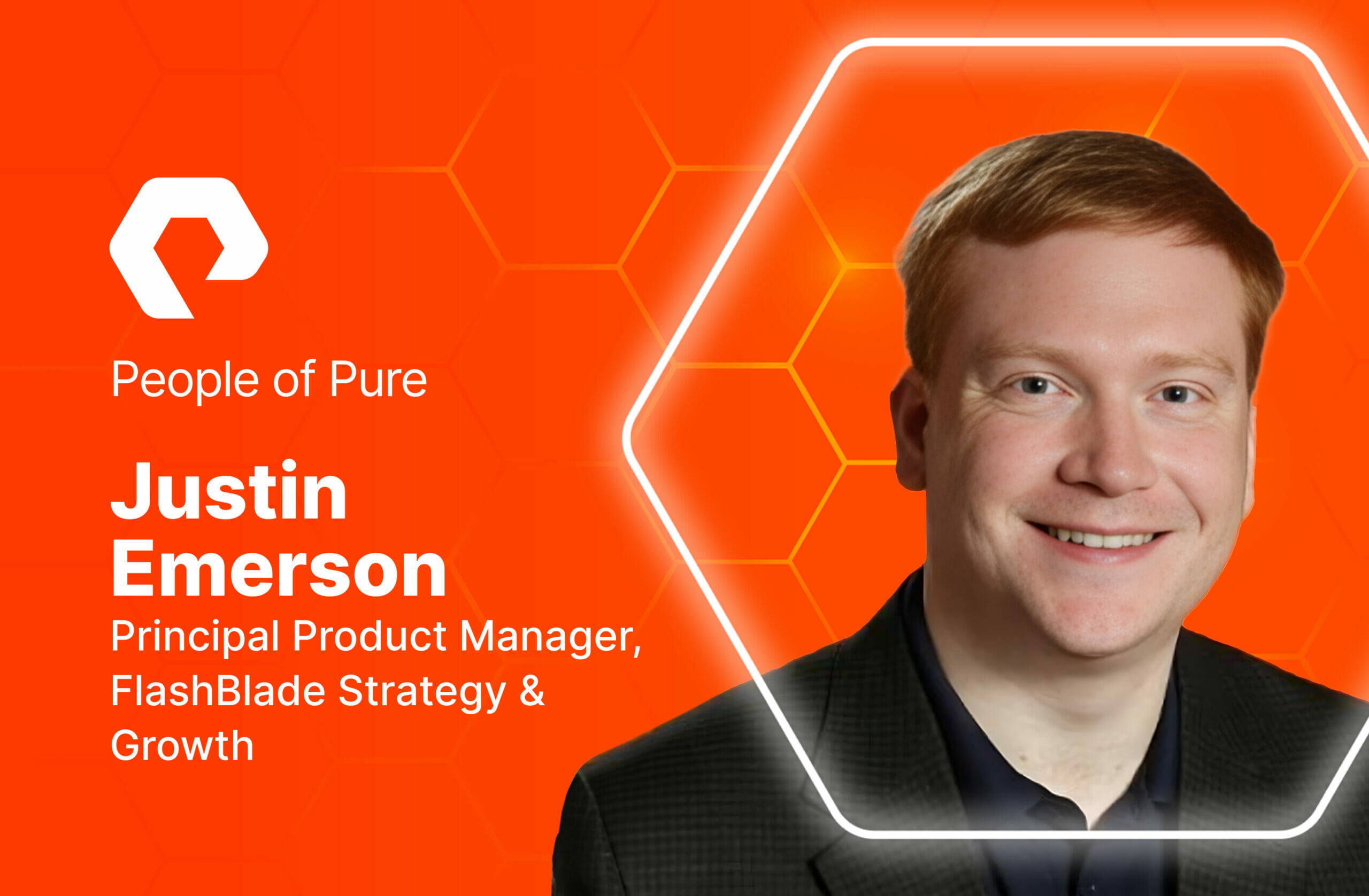“I don’t like to talk about competitors, but if you can get somebody to believe that what you do is different from everybody else, you don’t need to.”
Welcome to Justin Emerson’s mission and modus operandi as FlashBlade® Principal Product Manager and Technical Evangelist, a title whose religious intonations, he says, are not necessarily something to dismiss.
“It’s a very interesting title because it doesn’t really describe necessarily what the activities are, but very much describes what the objective is,” Justin says. “Evangelism, whether it’s in the religious context or otherwise, is about believing in something and trying to get others to believe that same thing—the idea being that we believe what we have is a truly unique, differentiated technology. Being a technical evangelist means getting other people to believe that what we have is indeed really different, based not on faith but on evidence.”
And with nearly a decade working within the Pure Storage ecosystem, who better to elucidate and prove Pure’s differentiators than Justin?
Let’s get to know FlashBlade’s official non-sales cheerleader and one of Pure’s longest-standing fans.
The Path to Pure
“I’d been trying to get to Pure for a while,” Justin says. “My first experience with FlashBlade was actually before it was called FlashBlade.”
During a visit to Mountain View, CA, in June of 2015, Justin got to see and talk to Pure co-founder John Hayes, who showed him a FlashBlade prototype, then called Iridium.
“I thought it was just such an amazing piece of technology, and I wanted to come here and either work on it or sell it or work with it, because I thought it was just so, so incredibly cool,” Justin says.
Prior to Pure, Justin worked for ePlus Inc, one of Pure’s first partners, so he’s been in the Pure orbit for nearly 10 years. His journey paints a beautiful map not just of a career in tech but of the evolution of flash itself.
Joining Pure and Embodying the Pure Mission
Justin started off as a data architect, a role he says was essentially a FlashBlade sales engineer, covering enterprise accounts in the Bay Area, where some of Pure’s largest and most cutting-edge customers are based. In 2022, in anticipation of Pure’s launch of an entirely new FlashBlade platform family, the product team was looking for someone to own technical messaging, and that’s when Justin joined.
“I knew that 2022 would be the most exciting year for FlashBlade since its launch,” Justin says.
Those product launches—FlashBlade//S™ in 2022 and then FlashBlade//E™ in 2023—represented a culmination of much of the vision of that original Iridium project. The idea of direct to flash management—writing to flash directly—was born with Iridium and then adopted by FlashArray™ with the introduction of DirectFlash® Modules in 2017. With the new family of FlashBlade platforms, those DirectFlash Modules are now used across the entire product portfolio.
“If you want to think about our mission as a company, first of all, it’s to be the best, most customer-friendly storage company that there is,” Justin says. “But the way we actualize that has a lot to do with the disruptive power of flash and the recognition by our founders that flash, as a technology, was going to disrupt the storage industry so much that it would provide an opening for a company like Pure to really accelerate the transition to flash and become the best company that does flash.”
Ultimately, Justin says, Pure’s mission comes down to one thing: building a better mousetrap.
“If you think about the mission of an electric car company saying, ‘we want to get all of the combustion engine cars off the road,’” he says. “Similarly, we want to get all of the spinning hard drives out of the data center and into the recycling center—not the landfill but the recycling center—because flash is just better.”
Justin’s no stranger to the evolution of storage technologies. The first computer he ever used—an IBM PCjr when he was six years old—had a 5.25” floppy drive and two cartridge slots. Since then he’s seen 3.5” floppies, zip disks, CD-Rs, Jaz drives, DV tape, and DVD-Rs all come and go. But one constant had always been the spinning and clicking of the venerable hard disk.
The Rise of Flash
“We’ve reached the crossover point where now disk has to justify its existence or provide a reason to justify why you should use it for a project and not flash,” he says. “That’s an enormously important pivot point and it’s one that we’ve been working towards for a decade, consciously.”
“The first time I switched to using an SSD in my home computer, I was blown away. I had been using PCs for 20 years, had been building my own for more than 10, and never before had there been an upgrade that was so transformative.”
The one historical advantage disk has had over flash—cost—is rapidly eroding.
“It’s all about economies of scale,” Justin says. “As we’ve seen over the last decade, semiconductors have a pretty predictable way of coming down in price and increasing in density. The first SSD I ever bought was only 160 gigabytes of capacity, and now in my PC at home, I have drives the size of a stick of gum that are 12 times larger than that. And at Pure, pretty soon we’re on the cusp of delivering drives almost 500 times larger than my first SSD.”
Better Science: Pure’s Fruit in Full Blossom
“Pure made a bunch of very smart decisions that were forward-looking in a way that didn’t necessarily bear fruit right away but are about to really blossom,” Justin says.
Pure started out focusing only on flash, he explains, which created opportunities for Pure to do things differently, while incumbent players split their focus by continuing to sell spinning disks, and most other startups or disrupters focused on hybrid solutions of disk and flash.
“[All the other new players] either went out of business, changed their model and went into some kind of software thing, or got acquired by somebody else,” Justin says. “And a lot of them were like, ‘We’re gonna focus on this sort of hybrid solution where it’s like we’re gonna have disk and flash,’ and that was kind of like the hybrid automobile idea. But the hybrid automobile was a stepping stone to fully electric cars. So there’s a particular shelf-life that that solution’s going to have. Whereas we said, ‘No—we’re just going to go straight to the thing that’s going to be the long-term solution.’ And that presented us with a bunch of really interesting opportunities to engineer our product fundamentally differently.”
As flash got denser and more sophisticated, it put Pure in a position to leverage those advances faster and more reliably, Justin explains.
This is a fundamental part of what Justin calls “Better Science”—how he likes to frame Pure’s advantage in the market.
“If you engineer around the characteristics of flash, which means both its strengths and weaknesses, you can then build systems that leverage the latest technology faster,” Justin says. “We’re ready to adopt the latest generations of NAND as quickly as they’re available, whereas a lot of the other people who don’t have that technology in-house—they’re leveraging commodity drives—they’re reliant on a particular critical mass of people wanting something and then drive manufacturers making it and then them adapting their software to deal with its shortcomings. And that’s a much harder problem.”
“My first SSD plugged into the same interface as a spinning disk, and my operating system treated it that way, too. This was before things like NVMe, or even like the TRIM command. And aside from those few changes in the transport and command set, SSDs today may be more sophisticated but they haven’t been able to break that mold of essentially slotting in to replace a hard drive.”
Pure Juice: The Future of Pure
What’s next? For Justin, it’s all about watching Pure harvest what it’s planted.
“Our bet was that high-performance file and object were going to become a market that needed platforms that could deliver that kind of performance and innovation in preparation for the explosion of big data and the response to big data, which was if we’ve got all this data how do we do anything with it?” This turned out to be artificial intelligence and machine learning, which are only viable thanks to the tremendous amount of data that has been collected in the last two decades.”
“That’s why I’m so excited about the next five years for Pure,” Justin says. “Because this is when a lot of those really key technology investments that we started 5 to 10 years ago are going to start truly making it hard for anybody else to compete because of the density and the performance and the speed at which we’re going to be adopting these new NAND technologies.”







